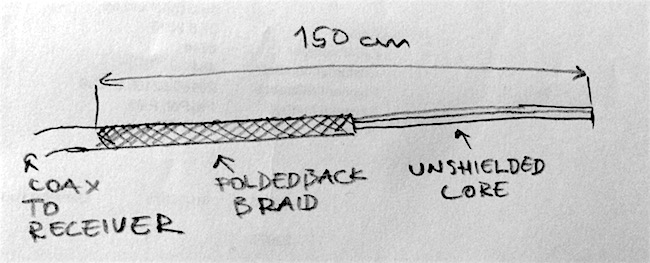Super simple FM band antenna
This antenna design originates, as I understand, from "Simple, Low Cost Wire Antennas for Radio Amateurs, by William I. Orr and Stuart D. Cowan", and is really easy to build.
Basically it is half wavelength dipole where the coax cable is inside one of the halves. The drawback is that it needs to be made ridgid with insulating material to make it attachable to mast in traditional way, but it is great for hanging vertically from an end. Thats probably why the design is also known as vertical dipole antenna.
You can imagine it as two 1/4 wavelength pieces of metal tube, with coax fed throug one of them. The braid of the coax is connected to the half that the coax comes through, and center is connected to second piece, the tubes obviously need to be insulated from each other. However, in its simplest form it can be created entirely from a piece of coax cable that goes all the way to radio as a single piece, with appropriate connector in the end. You need 1.5 meter of the coax to create the antenna, in addition to feed line from antenna to receiver.
First strip 75 cm of outer insulation off without damaging the braid. Then slide the braid back little ways and carefully work in back over the cable, so that the braid itself forms a 'tube' around the coax. The center wire of the coax with plastic around forms the other half.

This works best for better quality cable that has good dense braid, preferrably copper. For cheaper, lower quality stuff I have found that a 75 cm long piece of 10 mm outer diameter copper tube works well, it can be pulled over the folded back braid and foil without being too tight or too loose, and then further fixed in place with couple of wraps of electrical tape around both ends.
So when you think you need an indoor antenna for FM receiver, just buy a ready-made coax of appropriate length with connectors in both ends, keep the end that plugs into your receiver intact. Cut off the other connector, fold back 75 cm of braid from the cut end and you are done. Even horizontally laid on top of a cabinet it will work way better than just a piece of bare wire.
Copyright © Madis Kaal 2000-